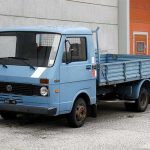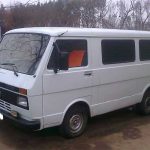
Legendary trucks Volkswagen LT 28, 35, 45, 46 - main characteristics and differences
Content
The Volkswagen LT series multi-purpose vehicles are well-designed and sought-after vehicles. During their history, since 1975, they have gained great popularity in Western and Eastern Europe, as well as in the CIS countries, including Russia. They represent a variety of modifications - from trucks and vans of various carrying capacities to passenger minibuses. The chief designer of the entire LT series was Gustav Mayer. These small economical vehicles are very well suited for companies and small and medium-sized businesses.
Volkswagen LT series of the first generation
Only in the first four years - from 1975 to 1979, more than 100 thousand cars of the Volkswagen LT series were produced. This suggests that the German automaker has created a highly sought-after modification of trucks and utility vehicles. A little later, the LT chassis was successfully used to install Westfalia and Florida touring car houses on it. Over the long history, these vehicles have been restyled several times, more and more modern models of this series have been periodically produced.
Photo gallery: Lasten-Transporter (LT) - transport for the transport of goods
-

- The LT 28 is a compact utility vehicle
-

- The LT 35 modification is made on a base common to the entire family, but is equipped for a flatbed truck
-

- The LT 35 brand successfully combines the advantages of a van and a truck, performing the function of a cargo van
LT 28, 35 and 45 models
The first generation of cars of these brands began to travel on the roads in the mid-70s of the last century. Their production was launched at the Volkswagen plant in Hannover. In addition to their functional purpose, they differ in full curb weight:
- for the light Volkswagen LT 28, it is 2,8 tons;
- "Volkswagen LT 35" medium-duty class in the same equipment weighs 3,5 tons;
- The maximum loaded Volkswagen LT 45 of medium tonnage weighs 4,5 tons.
Modifications of the LT 28 and 35 were multi-purpose - flatbed trucks, solid metal vans with low and high roofs, cargo, utility vans, as well as cars for tourists rolled off the assembly line. Cabins for the driver and passengers were made with one or two rows of seats.
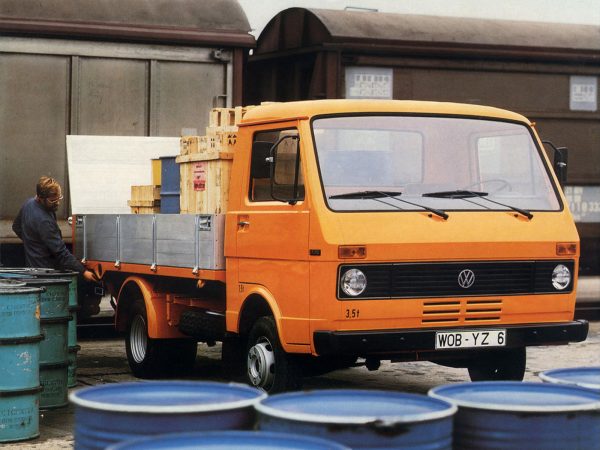
In 1983, the first restyling of the Volkswagen LT 28, 35 and 45 was carried out. In the same year, the production of the heaviest Volkswagen LT 55 began, which weighs 5,6 tons in full gear. The changes affected the interior trim and dashboards. The main components of the vehicles were also modernized. In 1986, the manufacturer decided to make the exterior more modern by changing the shape of the headlights to a square one. On all models, the body was strengthened and seat belts were installed. Another restyling was carried out in 1993. New grilles were designed, as well as front and rear bumpers. Dashboards and interior design have also been improved.

Machines of the first generation are still successfully operated. In numerous reviews of drivers, the fact that the cabs and car bodies are made and painted is very high quality. In the absence of mechanical damage, all Volkswagen LTs have a very good body condition, despite many years of operation. The interior is designed in the best traditions of the 70-80s of the last century. At that time, there were few adjustments and switches, since the cars were not stuffed with electronics, as they are now. That's why the dashboard is not rich in gauges.
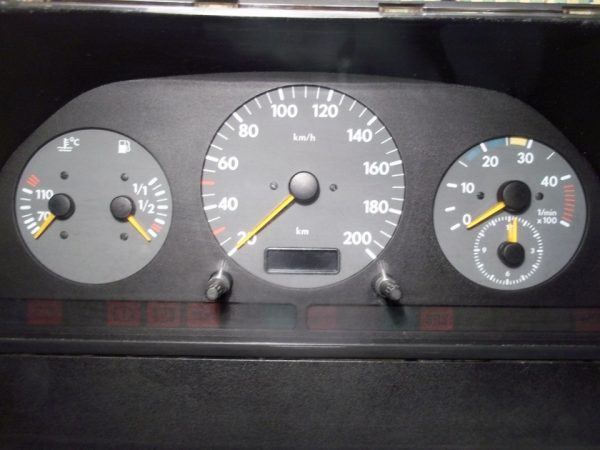
The steering wheel, as a rule, is large, attached to the steering column with only two spokes. This is due to the fact that the basic configurations were not equipped with power steering and column position adjustments. Adjustment is possible only in those machines where it was ordered as an option. Under the radio, a niche in the panel was already provided, but the cars were not equipped with it. The engine is located above the front axle, under the passenger seat. Thanks to this, it is spacious inside, providing good comfort to the driver and passengers.
Single-row cabins - two-door. Two-row are released in two versions: two- and four-door. Cabins with one row of seats can carry two passengers and a driver. Double-row except for the driver can accommodate five passengers. Minibus bodies had five doors. The LT series was so successful that it attracted the attention of another German company - MAN, a manufacturer of heavy trucks. A joint production of heavy vehicles under the MAN-Volkswagen brand was established. In this composition, these vehicles were operated until 1996. This year, the second generation of cars appeared - the Volkswagen LT II.
Technical specifications
The chassis for the entire LT family of the first generation had different lengths of 2,5, 2,95 and 3,65 m. Initially, the cars were equipped with two-liter carbureted four-cylinder Perkins 4.165 engines with a capacity of 75 horsepower. This engine has proven itself well, so it was installed until 1982. Since 1976, a diesel unit of the same company with a volume of 2,7 liters and a capacity of 65 liters has been added to it. With. It was also discontinued in 1982.
Starting in 1979, Volkswagen began to use six-cylinder gasoline, diesel and turbodiesel units, which used a unified cylinder block with a total volume of 2,4 liters and power from 69 to 109 horsepower. With such a cylinder block, in 1982, the production of a 2,4-liter turbocharged diesel unit with a capacity of 102 horsepower began. In 1988, a turbocharged modification of the same diesel engine appeared, only with a lower power - 92 hp. With.
On light and medium-duty vehicles, the front suspension is independent, double wishbones and coil springs. Heavy LT 45s already have a rigid axle on longitudinal springs assembled from several sheets. The transmission is a four- or five-speed manual gearbox. The clutch was supplied with a mechanical drive. The car was equipped with two types of drive axles:
- with a main gear having one stage, a differential with two satellites loaded with axle shafts;
- with single-stage final drive, differential with four satellites and loaded axle shafts.
For regions with poor road infrastructure, all-wheel drive vehicles were produced.
Table: dimensions of Volkswagen LT 35 and 45 truck modifications
| Dimensions, weight | Volkswagen LT35 | Volkswagen LT45 |
| Length, mm | 4850 | 5630 |
| Width | 2050 | 2140 |
| Height, mm | 2580 | 2315 |
| Curb weight, kg | 1800 | 1900 |
| Maximum weight, kg | 3500 | 4500 |
Video: Volkswagen LT 28, cab interior overview
Volkswagen LT second generation
In 1996, two eternal competitors - VW and Mercedes-Benz - joined forces. The result was the birth of a unified series with two brands: Volkswagen LT and Mersedes Sprinter. The entire chassis and body were the same. The exception was the front of the cab, engine and transmission lines - each automaker had their own. 1999 was remembered for the fact that Mercedes upgraded the dashboard and manual transmission controls. Volkswagen chose to leave everything as it was before.
In 1996, the LT 45 was replaced by a new modification - LT 46, weighing 4,6 tons in running order. The multi-purpose focus of the updated series has been preserved and even expanded. In addition to vans with different roofs, flatbed trucks, cargo and utility minibuses, minivans, buses and dump trucks appeared. The production of this series of Volkswagen cars continued until 2006.
Photo Gallery: Updated LT Series
-

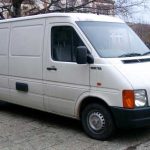
- In 1996, the front of the cab took on more modern forms.
-


- The car already has a hood through which there is access to the motor
-


- The Volkswagen LT 46 model appeared in 1996
Features of cars "Volkswagen" LT second generation
The curb weight of all cars is determined by the last two digits of the modification - exactly the same as in the first generation. Disc brakes were installed on the front and rear wheels of all LTs. The interior of the salon has changed. New, more ergonomic seats and a comfortable steering wheel shape, as well as the ability to make several adjustments to the driver's seat, including adjusting it to height, made the trips more comfortable. If in the first generation the power steering was an option, since 1996 it has already been present in the basic configurations. The wheelbases have also changed:
- LT 28 — 3000–3550 mm;
- LT 35 — from 3000 to 4025 mm;
- LT 46 — 3550–4025 mm.

 Modification LT 46 II began to be produced in 1996
Modification LT 46 II began to be produced in 1996
The driver's dashboard has a speedometer, tachometer, antifreeze temperature and fuel level sensors in the tank. The speedometer is combined with a tachograph. There are also a number of warning lights that provide further information to the driver. The control is simple, just a few handles and keys - you can turn on the heating of the windows, as well as adjust the power of heating and ventilation. The continuity of cab designs was preserved - VW produced single-row and double-row cabs with two and four doors for cars. The rear wheels on the 28 and 35 models are single, on the LT 46 they are dual. An ABS system became available as an option.
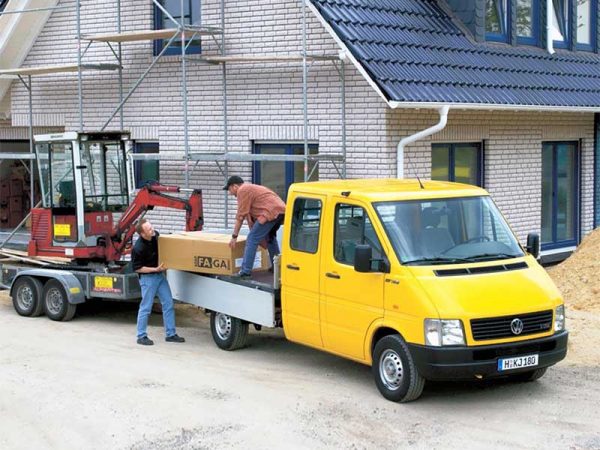

Brief characteristics
The LT now had four diesel powertrains. Three of them were of the same volume - 2,5 liters, had 5 cylinders and 10 valves, but differed in power (89, 95 and 109 hp). This becomes possible if the engine design is modernized. The fourth, six-cylinder diesel engine, began to be produced in 2002, it had a volume of 2,8 liters, developed a power of 158 liters. s and consumed only 8 l / 100 km in the combined cycle. In addition, a four-cylinder injection engine with distributed injection with a volume of 2,3 liters and a power of 143 liters was present in the line of power units. With. Its combined cycle gas consumption is 8,6 l/100 km.
For all second-generation cars, the front suspension is independent, with a transverse leaf spring. Rear - dependent spring, with telescopic shock absorbers. All cars of the second generation had a rear axle differential lock. This possibility made it possible to sharply increase the cross-country ability in difficult weather and road conditions. The automaker gave a 2-year warranty for all LT series cars, and a 12-year warranty for the bodywork.
Table: dimensions and weight of cargo vans
| Dimensions, base, weight | Volkswagen LT 28 II | Volkswagen LT 35 II | Volkswagen LT46 |
| Length, mm | 4835 | 5585 | 6535 |
| Width | 1933 | 1933 | 1994 |
| Height, mm | 2350 | 2570 | 2610 |
| Wheelbase, mm | 3000 | 3550 | 4025 |
| Curb weight, kg | 1817 | 1977 | 2377 |
| Gross vehicle weight, kg | 2800 | 3500 | 4600 |
The table shows vans with different wheelbases. If the bases of different modifications are the same, then their dimensions are also the same. For example, minivans LT 28 and 35 have a wheelbase of 3 thousand mm, so their dimensions are the same as those of the LT 28 van with the same base. Only curb weight and gross weight differ.
Table: dimensions and weight of pickups
| Dimensions, base, weight | Volkswagen LT 28 II | Volkswagen LT 35 II | Volkswagen LT46 |
| Length, mm | 5070 | 5855 | 6803 |
| Width | 1922 | 1922 | 1922 |
| Height, mm | 2150 | 2155 | 2160 |
| Wheelbase, mm | 3000 | 3550 | 4025 |
| Curb weight, kg | 1857 | 2031 | 2272 |
| Gross vehicle weight, kg | 2800 | 3500 | 4600 |
There are no advantages and disadvantages of some modifications in relation to others. Each of the models has a certain load capacity, which determines its scope. The whole series is multi-purpose, that is, its models are produced in a variety of modifications. The unification in terms of engines, cab interiors and running gear further eliminates the differences between the LT 28, 35 and 46.
Video: "Volkswagen LT 46 II"


Watch this video on YouTube
Advantages and disadvantages of cars with gasoline and diesel engines
What is the difference between petrol engines and diesel engines? In terms of design, they are identical, but diesel engines are more complex and massive in design, which is why they are more expensive. At the same time, they are more durable due to their features and the use of better materials in the manufacture. The fuel for diesel engines is cheaper diesel fuel, for injection engines - gasoline. The air-fuel mixture in injection engines is ignited by a spark formed by candles.
In the combustion chambers of diesel engines, the air pressure rises from its compression by the pistons, while the temperature of the air mass also rises. Then, when both of these parameters reach a sufficient value (pressure - 5 MPa, temperature - 900 ° C), the nozzles inject diesel fuel. This is where ignition occurs. In order for diesel fuel to enter the combustion chamber, a high-pressure fuel pump (TNVD) is used.
The peculiarity of the operation of diesel power units allows them to gain rated power even at a low number of revolutions, starting from 2 thousand per minute. This is due to the fact that diesel does not impose requirements on the volatility of diesel fuel. With gasoline engines, the situation is worse. They gain nameplate power only from 3,5-4 thousand revolutions per minute and this is their drawback.
Another advantage of diesel engines is efficiency. The Common Rail system, which is now installed in all European-made diesel engines, doses the supply of diesel fuel with an accuracy of milligrams and accurately determines the time of its supply. Due to this, their efficiency is almost 40% higher compared to gasoline units, and fuel consumption is 20–30% lower. In addition, there is less carbon monoxide in diesel exhaust, which is also an advantage and now complies with the Euro 6 environmental standard. Particulate filters effectively remove harmful mixtures from exhaust.
It is worth noting that diesel engines produced 30 years ago are still more economical than carburetor gasoline engines of the same production period. The disadvantages of diesel units include a higher noise level, as well as the vibration that accompanies their work. This is due to the fact that a higher pressure is formed in the combustion chambers. This is one of the reasons why they are made more massive. There are also other disadvantages:
- sensitivity to fuel quality;
- high cost of repairs;
- small speed range (up to 4500 per minute).
Knowing the features of both types of engines, each future owner can choose to buy a more expensive diesel package or prefer the option with a gasoline engine.
Video: diesel or gasoline injector - which engine is better
Reviews of owners and drivers about Volkswagen LT
The first and second generation LT series have been in operation for a long time. "Volkswagen LT" of the first generation, released from 20 to 40 years ago, is still on the move. This speaks of the excellent "German" quality and good condition of these machines. Rarities cost from 6 to 10 thousand dollars, despite their advanced age. Therefore, the ratings of these cars deserve attention.
Volkswagen LT 1987 2.4 with manual transmission. The car is great! Went on it for 4 years and 6 months, there were no problems. Running soft and hardy. After the bulkhead bulkhead, only after 2 years it was necessary to replace the right upper ball and outer bushings of the stabilizer. The engine is reliable and simple. Consumption in the city up to 10 liters (with such and such dimensions). It is stable on the track, but due to the large windage it is sensitive to gusts of wind. The cabin is very spacious. After you get into a GAZelle, Mercedes-100 MV, Fiat-Ducat (until 94) and really understand that you are the owner of a super cabin. Body frame, overload is not afraid. In general, I liked the car. I sold it two months ago, and I still remember it as a faithful and reliable friend…
Volkswagen LT 1986 Very reliable car. Our "Gazelle" does not go to any comparison. Almost the entire mileage of the car is with a load of up to 2,5 tons. Operated in winter and summer. Unpretentious to our fuel and oil. Locking the rear axle — this is what you need in the countryside.
Volkswagen LT 1999 The car is wonderful! The gazelle will not stand next to it, it keeps the road perfectly. At a traffic light, it easily leaves the place from a domestic passenger car. Those wishing to purchase an all-metal van, I advise you to stay on it. Much better than any other brand in this class.
Commercial vehicles produced by the Volkswagen concern are so reliable and unpretentious that it is very difficult to find negative reviews about them.
Volkswagen has done its best, producing reliable and unpretentious commercial vehicles for more than 4 decades. The fact that the leading European automakers - MAN and Mersedes-Benz - proposed the joint development of such vehicles, speaks of the unquestioned authority and leadership of Volkswagen. Periodic modernization and the introduction of the latest innovations have led to the fact that in 2017 his latest brainchild - the updated Volkswagen Crafter - was recognized as the best van on the European continent.


